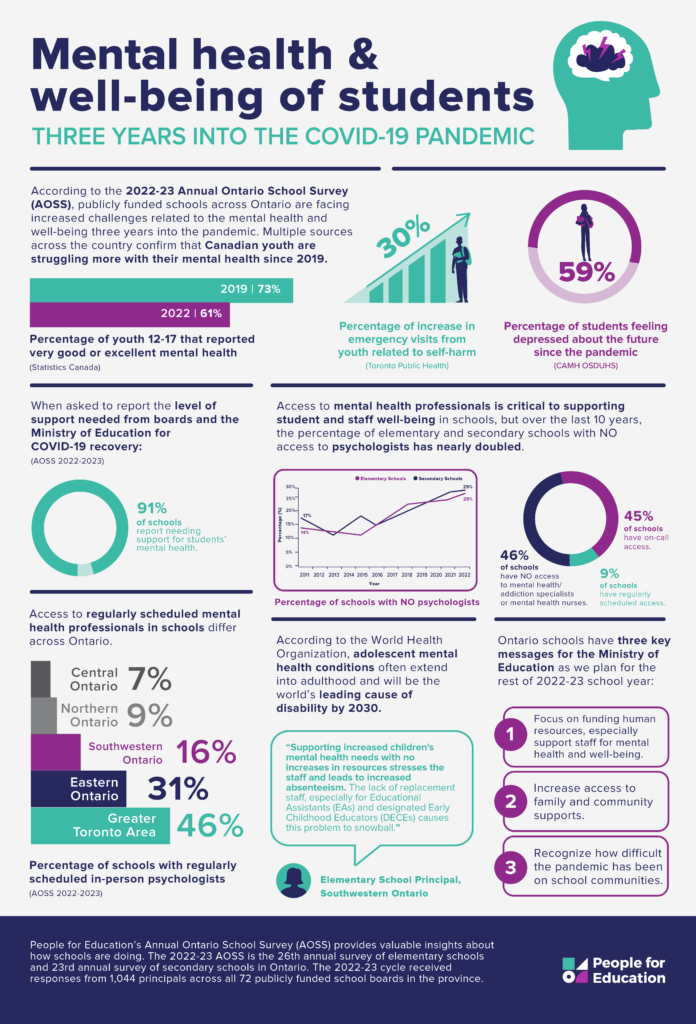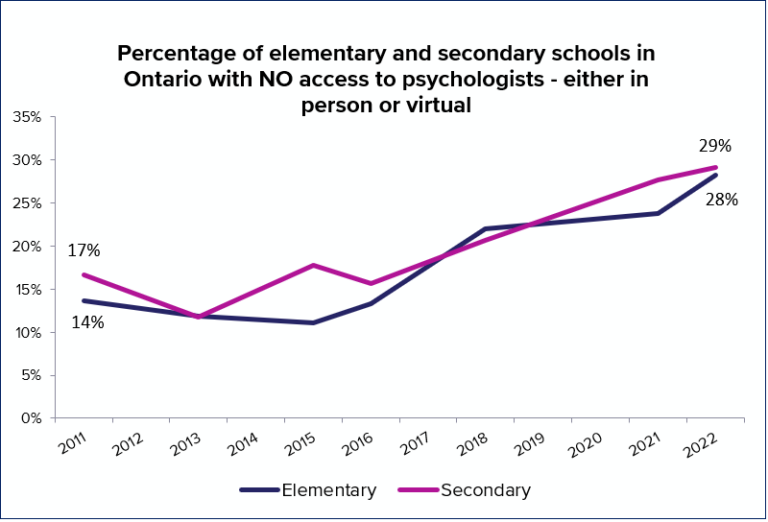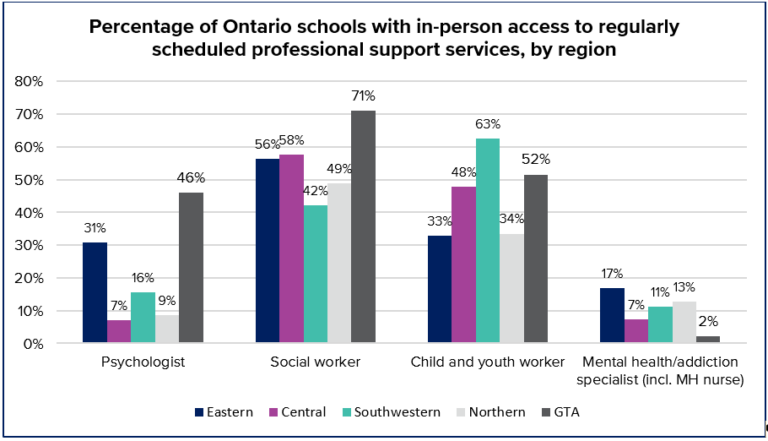Principals sound the alarm about students’ mental health
Ontario’s principals say their schools are not sufficiently supported to help students who are continuing to struggle with the aftereffects of the pandemic. In the responses to People for Education’s 2022-23 Annual Ontario School Survey (AOSS), principals report increased behavioural issues, students having difficulties with self-regulation, and a range of unaddressed mental health challenges.
New data from People for Education – based on survey responses from 1,044 schools across all 72 publicly funded boards in Ontario – reveal that the percentage of schools with no access to psychologists has doubled in the last ten years, and that geography plays a significant role in schools’ access to supports like social workers, mental health/addictions specialists, and child and youth workers.
Young people struggling across the country
 According to the World Health Organization, mental health disorders will be the world’s leading cause of disability by 2030, and “the consequences of failing to address adolescent mental health conditions extend to adulthood, impairing both physical and mental health and limiting opportunities to lead fulfilling lives as adults.”
According to the World Health Organization, mental health disorders will be the world’s leading cause of disability by 2030, and “the consequences of failing to address adolescent mental health conditions extend to adulthood, impairing both physical and mental health and limiting opportunities to lead fulfilling lives as adults.”
Recent data from Statistics Canada show an overall decline across the country in the mental health of young people aged 12 to 17. In 2019, 73% of 12 to 17-year-olds described their mental health as very good or excellent but in 2022, that number had declined to 61%.
A new report from Toronto Public Health also raises concerns about a nearly 30% increase in emergency room visits related to self-harm among children and youth. The report cites data from the Centre for Addiction and Mental Health (CAMH) surveys, where 59% of Ontario students stated that the pandemic has made them feel depressed about the future, and 39% reported that it has made their mental health worse.
In response to widespread concerns about young people’s mental health, CAMH is building a “Canadian Youth Mental Health Insight Platform (CYMHI),” which will not only facilitate research and knowledge sharing, but also provide a portal to match youth with available services in their area.
While schools alone cannot cure mental illness, they can provide the first door to services and support.
Mental health and wellbeing a top challenge for schools
We keep hearing about the mental health of students; however, where are the supports? There has not been an increase in the number of Child and Youth Workers, or social workers assigned to schools – in some cases, the youth workers are shared between two secondary schools and are not in their schools every day – you can’t build a sense of community and trust with students if you aren’t in the building.
Secondary school principal, GTA
At the beginning of the pandemic, most of the focus in Ontario schools was on COVID-19 safety and the logistics of remote learning. This year, principals are reporting mental health and well-being support are their top priority.
According to an elementary principal in the GTA, “Student needs have increased significantly due to COVID-19: self-regulation, literacy, numeracy, mental wellness. Due to the impact of COVID-19, many students are experiencing many more challenges.”
Among the findings from the 2022-23 Annual Ontario School Survey:
- 91% of schools report needing some or more support for students’ mental health and well-being.
- Only 9% of schools report they have regularly scheduled access to a mental health/addiction specialist or nurse, and 46%% of schools report no access at all.
- 28% of elementary and secondary schools report they have no access to a psychologist, either virtually or in-person; nearly double the percentage with no access in 2011.
- 82% of schools report needing support staff such as educational assistants, administrators, and custodians.
- 56% of elementary and 64% of secondary schools reported collaborating with local mental health organizations, but principals commented that these types of collaborations could provide much-needed support for students and their families and relieve some of the added pressures on teachers.
Mental health challenges among students, families and staff have significantly increased. Having, at minimum. a full-time (not once a week/once a month) social worker and psychologist available at all schools would be hugely beneficial. There is so much support required for students, families, and staff.
Elementary school principal, Southwestern Ontario
Regional inequities
 Geography plays a significant role in schools’ level of access to staff who can provide support for students’ mental health. Rural schools are less likely to have access to psychologists, social workers, and mental health specialists, compared to schools in urban areas.
Geography plays a significant role in schools’ level of access to staff who can provide support for students’ mental health. Rural schools are less likely to have access to psychologists, social workers, and mental health specialists, compared to schools in urban areas.
As a principal in Southwestern Ontario reported, “Being in a rural community means that our students/families don’t have equitable access to services. Families would need to drive to the nearest city for assessments and most treatments – this means having to have access to a vehicle, money for gas, and the time to do so. There is no public transportation available.”
Staff burnout leads to downward spiral
What would help is personnel support when staff are off for mental health reasons. Those who are not off pick up the slack, resulting in mental health concerns of their own. It’s a downward spiral.
Elementary school principal, Southwestern Ontario
Principals also raised serious concerns about the mental health and well-being of their staff. In many of their responses they said that both teaching and support staff were experiencing burnout, which was leading to an increase in staff mental health issues, then in turn led to increased absenteeism and increased pressure among remaining staff.
In some cases, principals report they have funding for mental health workers, but none are available in their communities.
Staff are expected to deliver mental health and well-being supports, but they themselves are in need of mental health and well being supports. The workload of the past two+ years has only increased (and no indication of it levelling out). They are overloaded and overworked.
Elementary school principal, Eastern Ontario
Recommendations for improved resources and education task force
Ongoing staffing challenges, lack of daily staff supports for post-pandemic recovery, daily bus cancellations, lack of system navigation and social work for all families, and a focus on ‘catching up’ when massive structural issues continue to be major challenges. The idea that we are ‘back to normal’ seems to reign, yet every day is a challenge for staff and families. This places incredible pressure on administrators and staff who consistently attend work, further burning out essential staff. With labour challenges at the forefront and possible strikes, it remains unseen how much more the system can bear.
Elementary school principal, Northern Ontario
In their responses, principals outlined three key messages for the Ministry of Education:
- Focus on funding human resources, especially support staff for mental health and well-being.
- Increase access to family and community supports.
- Recognize how difficult the pandemic has been on school communities.
Since the beginning of the pandemic, People for Education as well as others have recommended that the province establish a Task Force with participation from all education stakeholders including directors of education, teachers’ federations, principals’ councils, unions representing support staff, early childhood education organizations, public health, trustee associations, student organizations, School Mental Health Ontario, deans of education, and Indigenous education associations.
Principals’ responses to the 2022-23 AOSS paint a picture of a system and the people in it under severe stress. An education task force could work to evaluate whether funding is adequate, and that staff and students are supported by comprehensive policies and programs to address the currently increasing demands for mental health and well-being supports across Ontario’s publicly funded schools.
